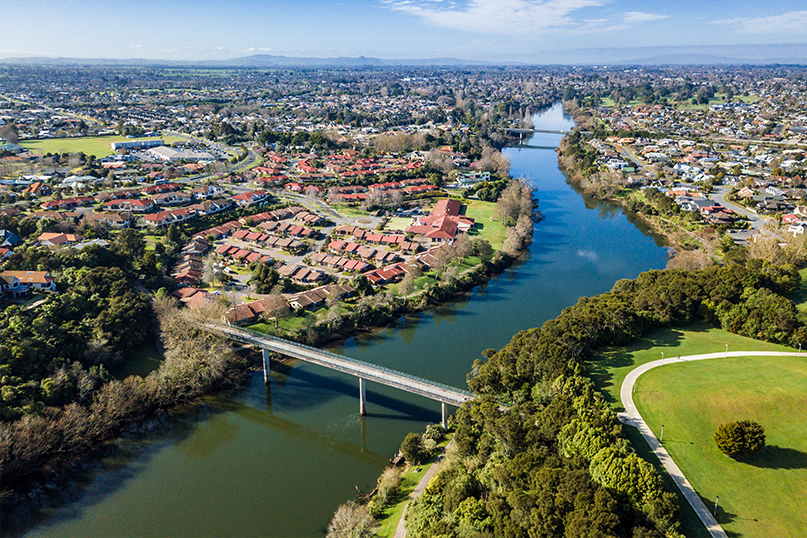
Please note: This project was not funded as part of the 'shovel-ready' projects from Government. The concept of a 20-minute city is something we continue to aspire to through our Access Hamilton Strategy, Ara Kootuitui Kirikiriroa.
A joint Waikato bid for money to rebuild the regional economy pitched 23 projects to Government. Now, 22 of those projects have moved to the next assessment step. All create much-needed jobs, but one has the potential to fundamentally change the way Hamiltonian’s live their lives for generations to come.
The project’s called the 20-Minute City.
Cr Angela O’Leary, Chair of Hamilton City Council’s Infrastructure Operations Committee, says referring to the project as ‘ground-breaking’ is a massive understatement.
“In its simplest terms, it’s about linking existing destinations with walking, cycling and public transport connections, creating a city which means most residents can safely access most of the things they need within 20 minutes, without relying on private vehicles,” Cr O’Leary says,
“But the flow-on effects of implementing this project go much further – changing the way Hamiltonians interact with our environment, reducing isolation, freeing up time and money for social and family connections, improving health, slashing carbon emissions and easing congestion in one of New Zealand’s fastest-growing cities.”
The 20-Minute City concept, if implemented, would put Hamilton at the cutting edge of global research into holistic city planning, providing a living laboratory for social improvement through integration of urban design, environmental sustainability and ‘people-first’ infrastructure.
As Eeva-Liisa Wright, General Manager Infrastructure Operations explains, the Council and Waka Kotahi NZ Transport Agency had already taken steps which align with a 20-Minute City.
“Transport and infrastructure programmes already planned or envisaged are in place. Data-led research on pedestrian and cycle movements are being developed using the latest technology to understand and predict movements around the city to understand and improve connectivity. Mass transit planning as part of the Hamilton-Auckland Corridor Plan has been under way for some time as the region develops a transport-led growth plan for the wider region,” Ms Wright says.
“This work meant the city was ideally positioned to provide Government with a suite of ‘shovel-ready’ projects it could link together immediately, fast-tracking a whole-of-city approach to connectivity and local living.”
One of many currently being considered by Government, decisions about what projects will be supported across the country are expected during the next few months. As an infrastructure project, the 20-Minute City offers almost 12,000 job-years and it could start tomorrow.
But what takes this project far beyond the already-critical goals of a rejuvenated local and regional economy is a partnership with the University of Waikato to systematically assess the benefits the project delivers.
Cr O’Leary says this partnership is a milestone moment.
“For the first time in New Zealand we will be able to evaluate the economic, social and health effects of this approach on a city scale, providing clear data and evidence to inform similar approaches throughout the country,” she says.
“Hamilton is ideally suited to the project on many levels. Geographically it’s compact and its terrain is suited to active transport modes. It has a young, diverse and innovative community which embraces positive change. It is a tech-savvy city, with the digital know-how to deliver research and development on the world stage.”
Perhaps most importantly, the city still has time to make the change. It hasn’t yet got to the stage where retro-fitting a congested, disjointed metropolitan city is simply too difficult or expensive to fix.
If implemented, the 20-Minute City would literally change lives.
Financial barriers to connectivity would be reduced or removed. People could access neighbourhood parks, shopping centres, schools or workplaces safely and quickly. Fully-separated cycleways and pedestrian networks would mean parents are happy to let their children bike, scooter or walk to school, reducing weekly vehicle movements in the city by tens of thousands. Air quality would be improved as Hamiltonians make the choice to reduce single-occupant vehicle trips and in turn this would reduce the heavy-metal pollutants from stormwater runoff for our waterways.
“This project isn’t about stopping people using cars. It’s about providing city-wide viable alternatives for the first time. More importantly, it’s about providing people with that most-valuable of commodities – their own time,” Cr O’Leary says.
“It’s called a 20-Minute City, but those 20 minutes would be a life-changer for generations to come.”
